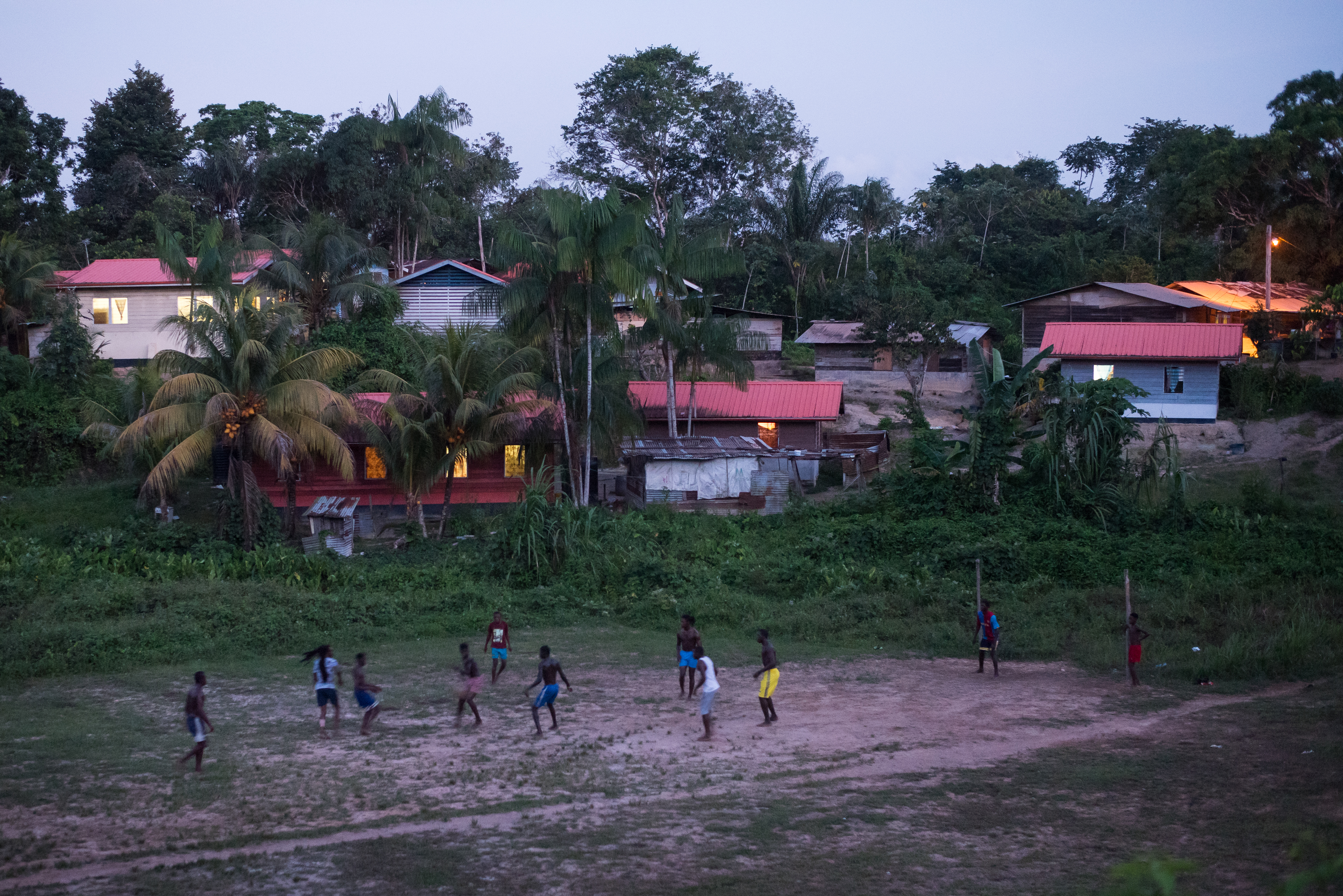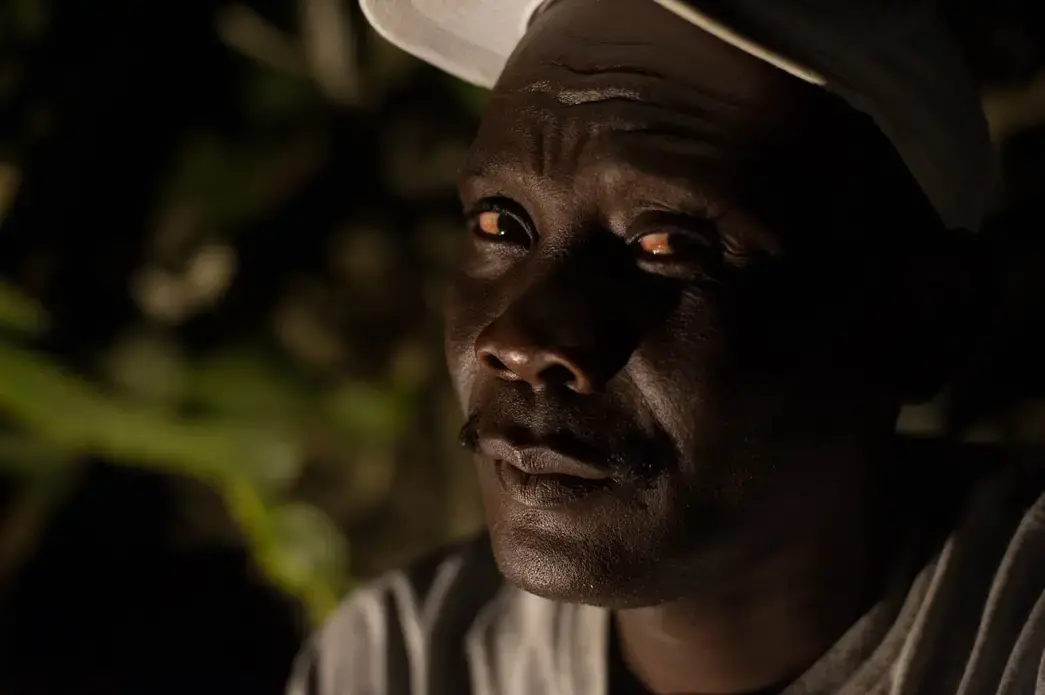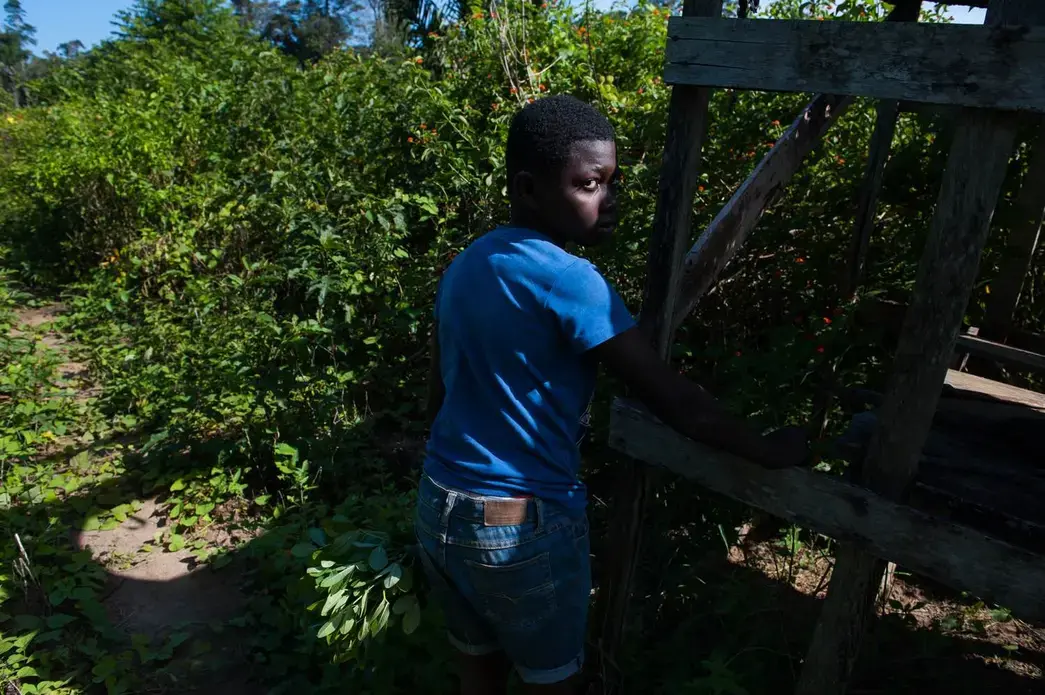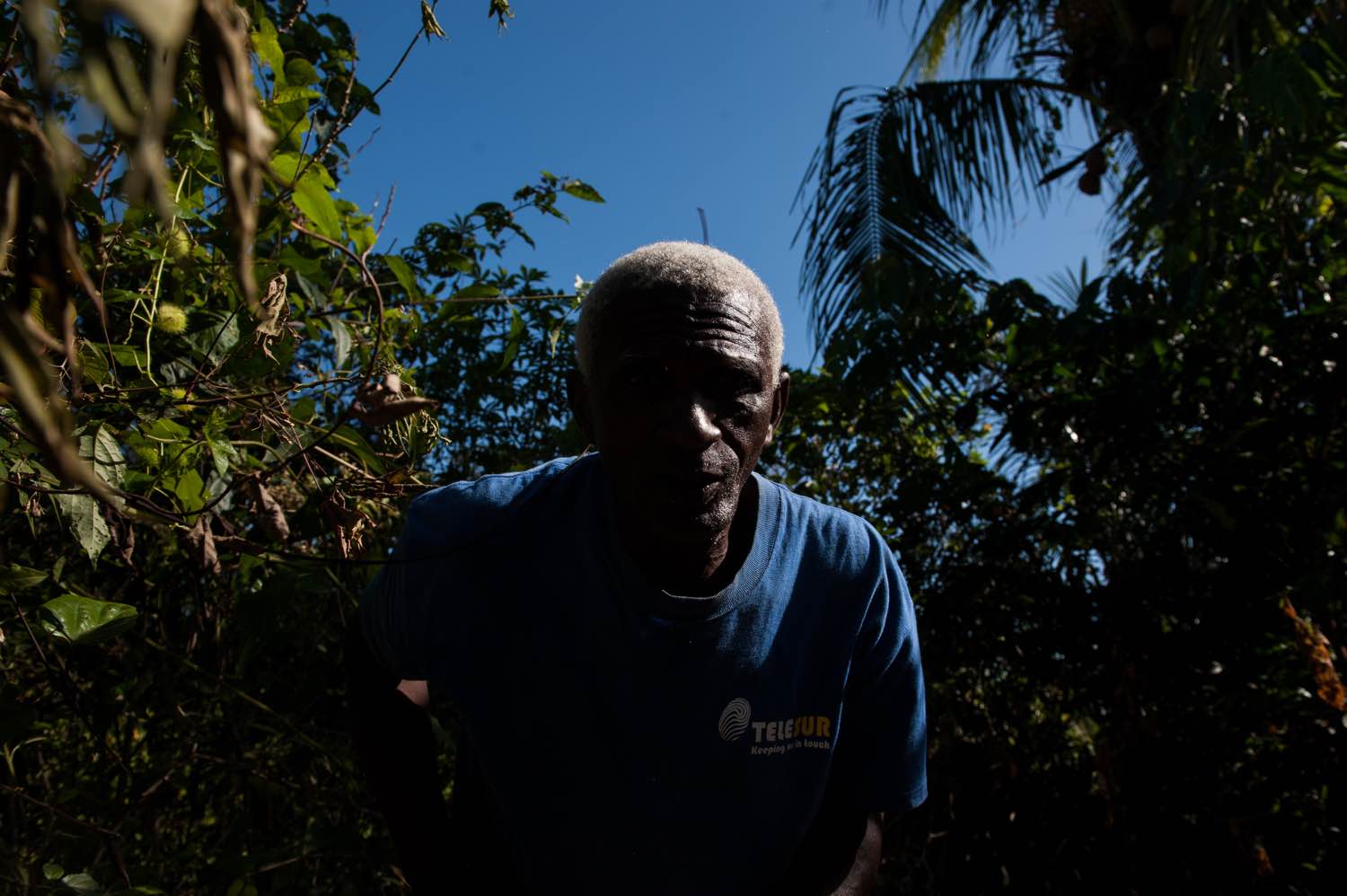
AFOBAKA ROAD, Suriname — In the shadow of power lines that run from Alcoa’s dam to this nation’s capital, Nelson Adose Martines is praying that a blackboard will be enough to propel his son from peanut farming to modernity.
Not that there’s anything wrong with living in a shack and subsisting on nuts, cassava, watermelon and jungle game, Mr. Martines, 59, said as he sat on the porch where his son does times tables in chalk. He's better off than many other Saamaka — descendants of runaway slaves who governed themselves for 200 years until the Afobaka Dam swamped much of their land.
“Where I am now, it’s easy for me to hunt and to find wild meat,” he said. But population relocations, he added, have made that difficult in many areas.
“That’s why I’m doing my utmost,” he said, with 11-year-old Adipi Revanildo nearby. “I bought a blackboard, I constructed a table and a chair so that he can do his homework."
The advantage of the blackboard: You never have to plug it in. There are no outlets here.
In 1964, Alcoa’s dam energized factories that the iconic Pittsburgh company built to turn bauxite into aluminum. Where forests had flanked the Suriname River, a 618-square-mile reservoir formed. Thousands of Saamaka fled, aided by a penurious government resettlement effort.
The dam electrified other parts of Suriname. But in the Saamaka clans’ tough-and-dusty gold mining towns and roadless jungle villages, power still flows irregularly, weakly or not at all.
The Saamaka lost hunting ground, while most villages didn’t even gain the power necessary to run a grocery store, clan leaders are quick to note. If they had electricity, "if we catch a fish, it would be possible for us to keep it fresh longer, in a refrigerator for example, or if we go hunting, it would also make it easier to preserve meat," said Stiefen Petrusi, captain of the village of Aurora and chairman of the Association of Saamaka Authorities.
The country’s politicians, though, barely mention the Saamakas’ demands. And Alcoa’s management, busy shutting down operations and negotiating the handoff of the dam to the country, maintains that electrifying the jungle is a government job.
Nonetheless, Capt. Petrusi has a pitch to the company that, since 1964, has dominated his people’s history: "We should get electricity before they finish off all their dealings in Suriname."
200 years of solitude
"It is a modern model of slavery in Suriname,” said Capt. Petrusi, as he drove a minivan south on the Afobaka Road.
As an advocate with modest funding, he works a smartphone as he drives freely between Aurora and the capital, Paramaribo. But many of his fellow Saamaka subsist on the jungle, the mines or the government dole — what he calls “metaphorical slavery” in which they’re becoming “even more dependent” on others.
Slavery is a loaded word here. Human bondage came to Suriname after it became a colony of the Netherlands in 1667. In the 18th century, Africans who had escaped into the jungle waged a decades-long war against their former masters. In 1762, the Dutch and the Saamaka sealed — by sharing a mix of their blood, rum and white clay — a treaty giving peace to the coastal whites and autonomy to the jungle Maroons.
Slavery was abolished in 1863. Suriname gained independence from the Netherlands in 1975. By that time, though, decisions made in Pittsburgh had reshaped the landscape.
Alcoa in the 1950s concluded that with enough electricity, it could mine bauxite, refine it and smelt it into aluminum — all right in Suriname. A key component would be a hydroelectric dam. In 1958, the company, the local minister-president and the Dutch governor signed on to the plan.
The Pittsburgh Press in 1959 heralded “a 10-year program which will increase production, employment and electric power, helping development in every way.”
The lengthy agreement between the country and company contained just one sentence, in a list of the government’s duties, about the people in the path of progress: “Remove the population, the buildings and other property from the reservoir area.”
Hiskia Jabini, now 81, trekked north from Aurora to Afobaka in the early 1960s, and became one of 2,300 laborers on a construction project that he little understood. “It was a way to earn money,” he said, speaking the Saamaka language (translated by Debora Linga), as did others interviewed for this story. "We didn't realize that, as a result of building the dam, our villages would be flooded and such a bad thing would happen.”
Praying to the tree
In Kajapaati, women carry towers of pots and pans on their heads down dirt paths to the Suriname River, where they wash the dishes, bathe the kids, sometimes catch a fish.
It’s an hour’s ride by motorized canoe to the nearest town served by any road. Decisions are made through a clan hierarchy of captains, including a head captain and lieutenants called “basjas.”
Basja Emelien Adjako was 5 years old in 1964, when the water overcame her birthplace of Bedoti, she said as she sat among the shacks of Kajapaati. She described Bedoti, with its sacred kankantrie tree. “The roots were so big you could compare it to a wall of a house.”
When the creeks started to rise, she said, the elders “were praying to this tree, praying that the water wouldn’t come higher. So they were looking for their salvation with this tree, but it was the first thing to flood.”
As the waters rose, she said, parents told each other, “You can’t look away from your child for even a second to kill a mosquito. Because of the water coming up very quickly, your child might drown if you looked away.”
As the flooding separated Bedoti from the farms, the parents moved the children to high ground and swam or took boats to harvest whatever they could. “I was hungry, and all of us, the only thing we were doing was sleeping, I guess because of the hunger,” she said.
Eventually her family accepted a government-provided evacuation by boat. "We couldn’t carry our chicken with us because there was no space in these boats," she said. The family settled in one of the government-provided "chicken coop-like houses," which still shelter villagers today.
The land around Bedoti, she said, "was ours, so we could use it freely." But Kajapaati was carved out of jungle claimed by another Saamaka clan. "We can’t even use it properly."
Kajapaati gets a few hours of electricity daily, via a generator and fuel irregularly supplied by the government. For her, the hydroelectric dam had no upside. "Because we, living in this village, we gained nothing at all.”
Aluminum to combs
In the months after its gates shut on Feb. 1, 1964, the dam flooded an area equivalent to 85 percent of Allegheny County, or the entire city of Houston. Forty-three Saamaka villages, with some 6,000 residents, had to be evacuated, according to Richard Price, an anthropologist, professor emeritus at the College of William & Mary and author of a dozen books on societies forged by escaped slaves. The government paid the equivalent of $4 to each displaced couple, or $12 per family with children, he wrote in “Rainforest Warriors.”
Displaced clans were pushed into the territory of others, stressing jungle resources and forcing more migration. Mr. Price, using census data and other sources, estimated that in 2014 there were more Saamaka living in the coastal capital (29,000) than in their traditional territory (28,500). A similar number had moved to neighboring French Guiana (25,000) or the Netherlands (7,500).
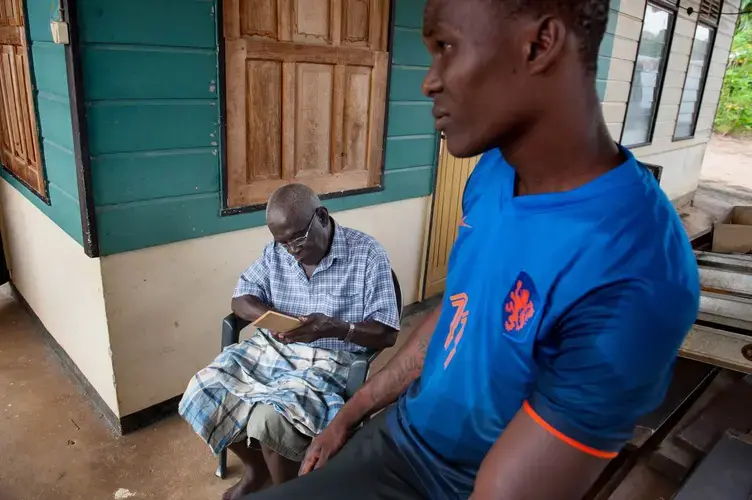
Some Saamaka tried it Alcoa’s way.
Mr. Jabini took a job in the company’s aluminum smelter in Paranam in 1965 and sweated out a living there for 21 years. His kids studied in Alcoa's schools, and one son — Hugo — became a member of the National Assembly and a voice for the Saamaka. Hugo has since emigrated.
The elder Mr. Jabini moved back to his native Aurora, where he still has company calendars — for 1996 and 1997 — on the walls. They’re there to remember, not celebrate, Alcoa, he said.
His pension? "You're going to laugh," he said, producing a statement showing a monthly payment equivalent to $27. The company also provides medical care.
He also gets a government benefit equivalent to $68, but it doesn’t last. Inflation in Suriname exceeded 55 percent last year.
"Since the prices are going up, everything is becoming more expensive,” he said. His solution? A knife, some wooden slats and the town’s trickle of cash-carrying tourists. “I started making combs, functional artwork."
'Not on the table'
Along the Afobaka Road, from the shuttered Alcoa complex in Paranam to the dam, the jungle regularly gives way to stumpy fields and murky wastelands. Mining and logging come at the expense of the forest animals, freshwater fish and jungle gardens that long sustained the Saamaka, Capt. Petrusi said. “With your eyes,” he said, “you see that development is the way to slavery.”
A decade ago, the Association of Saamaka Authorities sued Suriname before the Inter-American Court of Human Rights, alleging rampant logging and mining on their land, plus ongoing harm from the Afobaka Dam. The court ordered the government to give the Saamaka modest compensation for logging and mining, and some control over jungle resources, but rejected their claim of damages related to the dam on procedural grounds.

Alcoa maintains that it isn’t responsible for the Saamaka. “The transmigration of the people out of the [flooded] area was the responsibility of the government,” said Ruben Halfhuid, managing director of Suralco, Alcoa’s Suriname subsidiary. “That was their part of the deal.”
The company, though, maintains that it has tried to help. Alcoa-related contributions to Saamaka districts from 2003 to 2015 approached $800,000, including vocational training, upgrades to a school and a lodge, trail construction, health programs geared to women and teens, community radio, a biodiesel production effort, a water system upgrade and flood relief.
Such projects aren’t easy, said Akash Nendlal, a manager for Alcoa’s subsidiary who has worked in Saamaka towns, in an interview in the capital, Paramaribo. "If you walked around these villages, I am sure you were walking, thinking, ‘So, why don’t they have a straight road and why is my bathroom leading into your kitchen?’ ” he said. Efforts to build infrastructure are complicated by undocumented “invisible lines,” he said, between each family’s territory.
National Assembly member Wendell Asadang, who represents Saamaka areas, acknowledged that it was the government’s job, not Alcoa's, to move people displaced by the dam. “But still, as a responsible company, I think they should have done more to help these people.”
Would Alcoa contribute to a proposed government effort to install solar panels in Saamaka towns?
“For us, that is not on the table,” said Mr. Halfhuid, “because we are not doing business anymore.”
Meet the new metal
If Pittsburgh's hunger for aluminum undermined Saamaka society, the world’s $1,250-an-ounce obsession with gold may shatter its foundations.
A belt of gold deposits has attracted Toronto-based Iamgold Corp., plus traveling miners from Brazil and homegrown wildcat diggers known as “porknokkers” — a term said to come from Guyanese miners who continuously slapped flies from the salted pork they carried into the bush. From Nieuwe Koffiekamp, a village built for refugees from the flooded Saamaka villages, one can see the earthen mountain Iamgold built around its mine. Between the wall and the town is the deforested, eroded realm of the porknokkers, who use creek water and mercury to separate gold from clay.
Basja Richard Libretto of Nieuwe Koffiekamp said his people can no longer hunt in the area, their gardens are raided by porknokkers, and their creek is a murky mess. “It’s part of our culture to bathe in the creek, use it for dishes and household work,” he said, as he walked its muddy banks. The new water pipes are just not the same, he said.
In nearby Brownsweg, SUVs and quads rumble down sandy trails between government-built resettlement shacks.
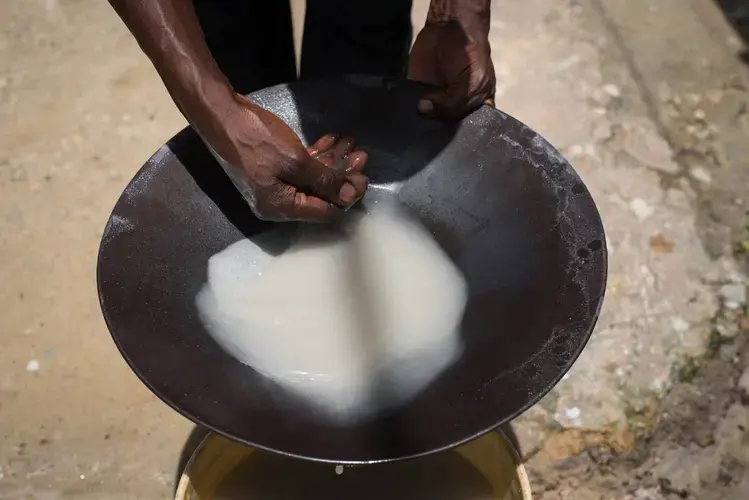
Frans Weewee’s family fled here from the village of Wakebasoe when the rising waters of Alcoa’s reservoir reached the schoolhouse steps. He became a teacher, but he left the country in 1989 when civil war destroyed rural schools and taught in the Netherlands until 2014. He returned with a dream to start a radio station.
“I was shocked when I came back,” he said. “I saw all of the young men with cars and so forth, and I said, ‘What is this?’ ”
It’s the glitter of gold, but the money won’t last, he said. “It's very bad that the young people no longer believe in education. The fathers are mostly not home — they’re in the gold fields. There is no family anymore, almost — sorry to say.”
Back along the Afobaka Road, Mr. Martines’ eight-person family includes his son from a defunct marriage, his wife, her grandchildren, a nephew and his wife. From tiny porches, they can watch the timber trucks and porknokker vans running — like the electrons in the wires above — from the reservoir’s shores toward the capital.
He said he’s been here, watching the electrified world pass his family by, for 30 years. He can charge a phone using a tiny solar cell, but he can’t run a laptop. So for now, it’s back to the blackboard.
“My hope and my thirst is that my son has a better future than the way I am now,” he said. In case that doesn’t work, he’s also teaching his son to pick peanuts.




